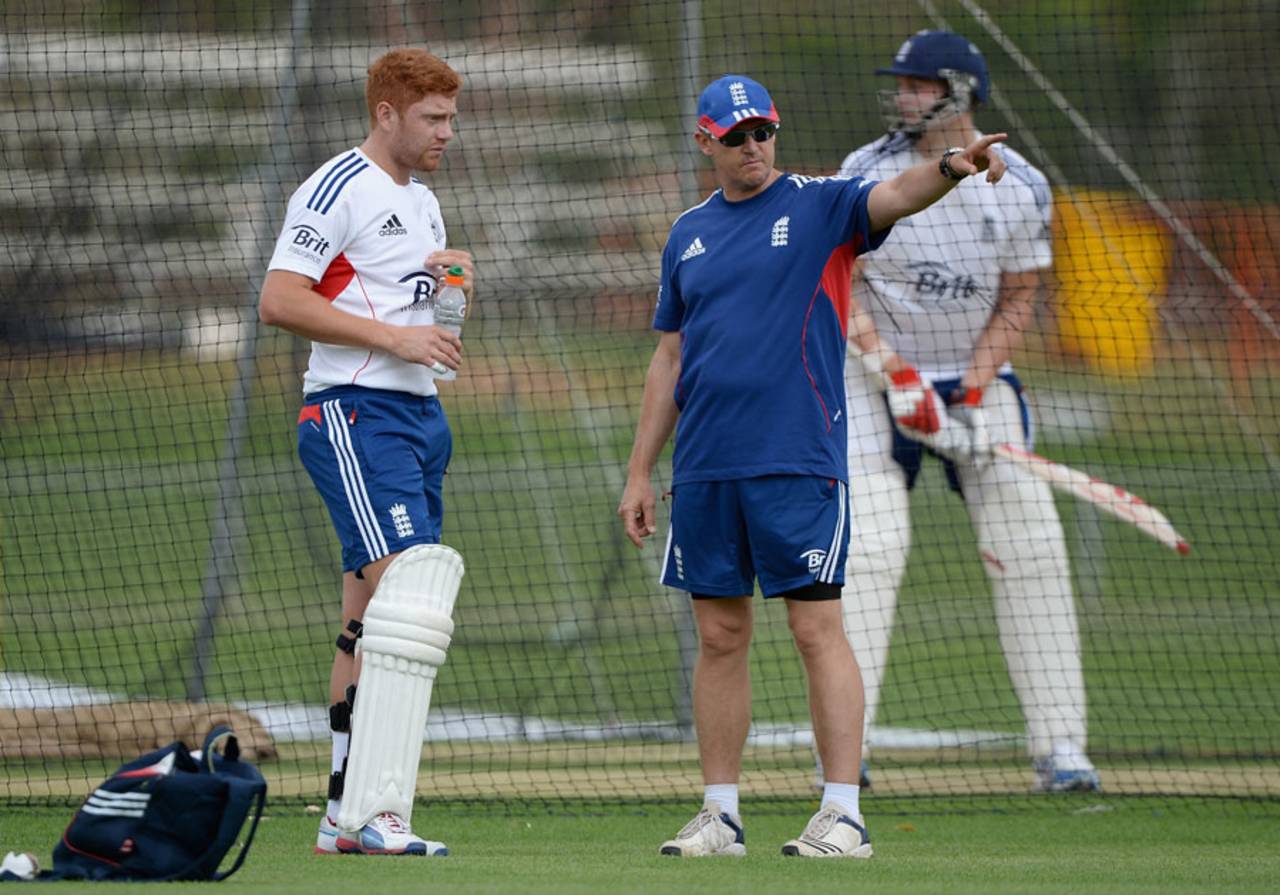Can Flower bring art to the science of coaching?
Great coaches understand the fluidity of technique, the role of imagination, the constant forward momentum of the game
Jon Hotten
04-Mar-2014

Andy Flower and his staff have been criticised for an over-reliance on statistical analysis • Getty Images
A long time ago now, my dad and me were in a junk shop, where he came upon a copy of Ranjitsinhji's Jubilee Book Of Cricket, first published in 1897. It's a wonderful edition, and as well as being a beautiful object, it's a time-traveller's dream. It's so close to the origins of the game that it has an almost haunting depth to it. Here was how the Victorian psyche saw the practice of cricket.
It's funny, too, in places: there's one wonderful plate captioned "a player illustrating a doubtful delivery", in which a glowering giant with a lantern jaw has a 45-degree break in his elbow. Darrell Hair would have loved him.
The fledgling development of the camera meant that every image had to be posed for some minutes, and there's a stillness to them that makes the era look more studied than it must have been (the plate of Ranji hooking looks more like he's about to put up a parasol on Brighton beach), and yet here is one of the very first times that the techniques of batting and bowling were recorded and described.
Who it was that actually did the describing has always been a matter for debate. Although the Prince's name adorns the cover, his friend CB Fry is thought to have written much of the text. Either way, it could not have had two more illustrious authors beyond the Grand Old Man himself. On the bombshell pitches of Victorian England, both averaged more than 50 - high-class today, but back then the mark of genius.
The young Ranji, new to the game in his late teens, had a common fault: backing away from fast bowling. In the nets at Cambridge, under the eye of a first-class player called Daniel Hayward, Ranji practised with his right leg tied to the ground. From there he found he could move his left leg across and flick the fast leg-side ball behind him in unorthodox fashion and the leg glance emerged, or at least it was popularised. (Who can say, in such an uncatalogued world, who was the first to do anything?)
Technique was not born with the game. It has always been a fluid thing, although for the best part of a century, while orthodoxy thrived in an orthodox and ordered world, it appeared to be an outpost of the stiff upper lip, administered by the MCC Manual and passed down in tablets of stone from one generation to the next.
When I was a slip of a lad I spent every winter Saturday at Alf Gover's school on the East Hill in Wandsworth. Many great players walked in through that slender side door (and many more, like me, who were far from great did too), but everyone who went passed under Alf's stern yet benevolent eye, and all would hear his famous cry of "one to drive" as he lobbed down one of his round-arm deliveries.
It would be hard to imagine someone more traditional than Alf - I never saw him without a crisp white cravat around his neck, England sweater stretching almost to his knees over immaculate cream flannels - but as a coach he adapted his principles to the individual. I saw plenty of West Indian and South African players there, who, by the standards of the day, were wild and instinctive, and all were encouraged to hit the ball and express themselves. There was a famous story that Alf told Vivian Richards he wouldn't make it because he hit across the line of the ball, but I never believed that. He may have advised him not to do it on early-season English pitches, but Alf would have recognised genius when he saw it. Here he is on the young Brian Lara, writing in the Cricketer magazine: "He had plenty of natural ability and we concentrated on enlarging his range of stroke play."
The great coaches understand the fluidity of technique, the role of imagination, the constant forward momentum of the game. Bob Woolmer's The Art and Science of Cricket, a book as meaningful in its way as Ranji's, incorporated a new level of research and sports science, a hint at an approaching future where some of cricket's great mysteries would be unravelled and studied. Yet even in his title he balanced it with the use of "art", because cricket is a game of artistry, a game that offers Graeme Smith and David Gower the same leeway in the methods of getting it done.
That's why it will be fascinating to see how Andy Flower envisions the future of coaching in his new role. To have responsibility for the development of coaches as well as players is truly to have his hands on the wheel. It's hard to think of anyone who has been handed such an all-encompassing brief in English cricket. Luck will play its role - Lara and Smith were born not made - but if there's a criticism of Flower's Loughborough empire, it's that the scientific revelations emerging from their studies are edging towards a homogenisation of technique, a regimentation governed by statistical analysis.
What would be fascinating, and revelatory, would be a book from Flower, a contribution to the literature of thinking about the game set down by Ranji (or CB) and Woolmer. It seems to go against Flower's somewhat opaque public image, but it could bring a new and welcome openness to English cricket's monolithic corporate face.